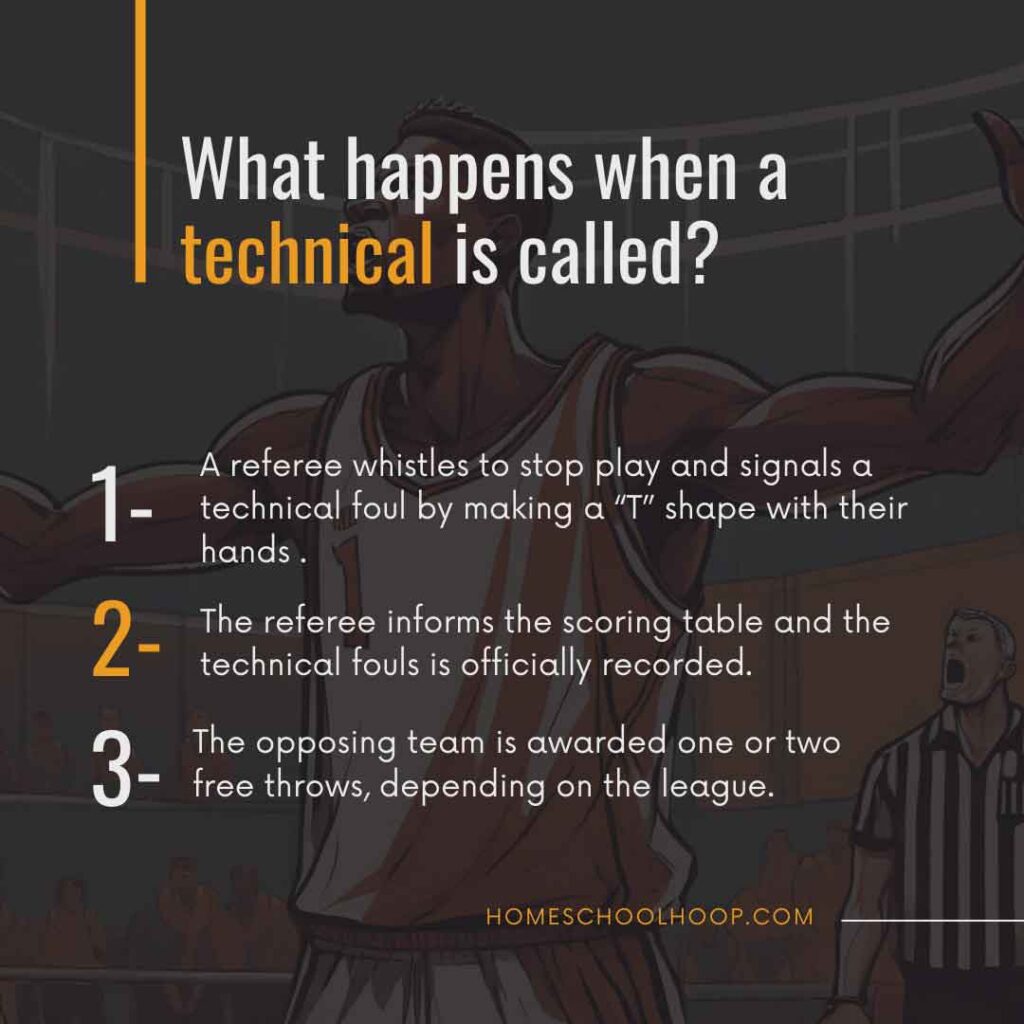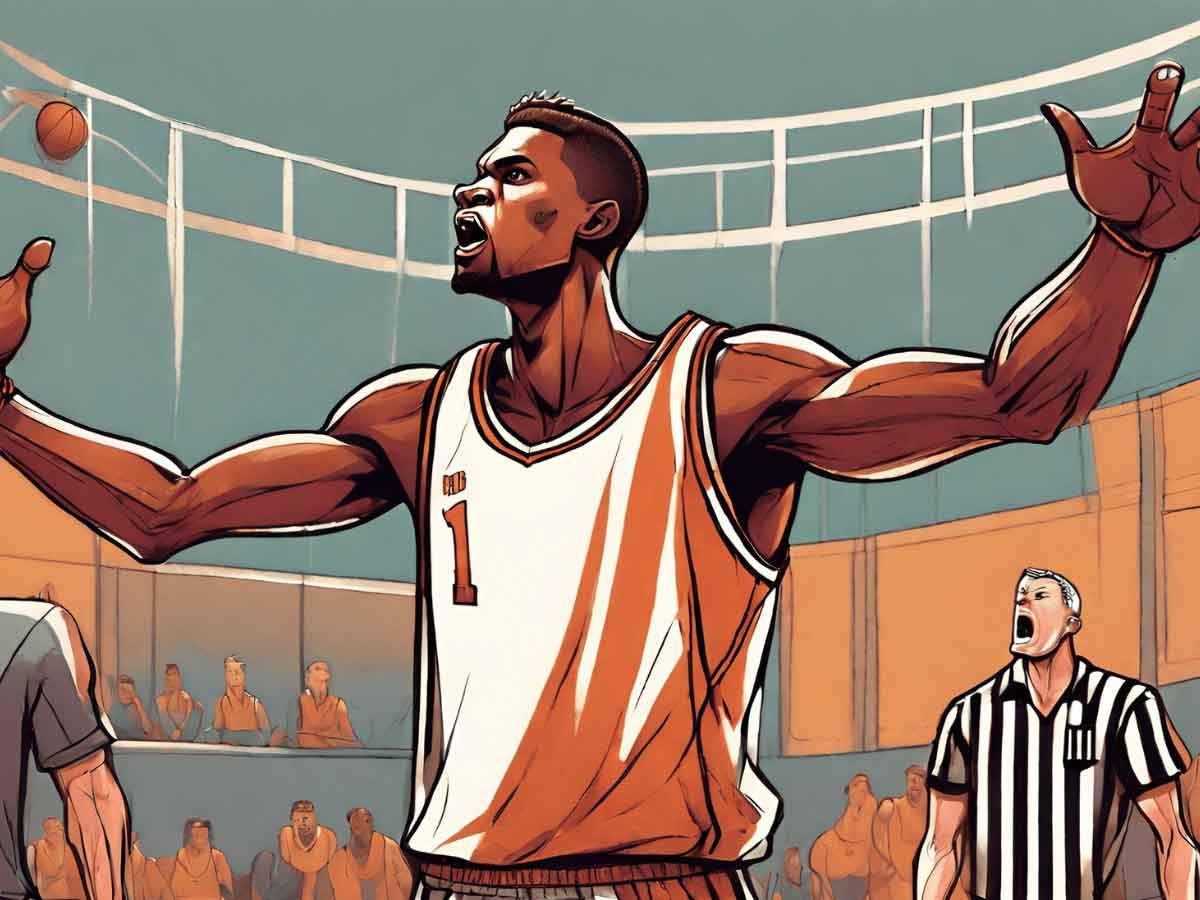Technical fouls in basketball can be mystifying. It is not always clear what has prompted a referee to stop the game with their whistle and signal with their hands to form the shape of a “T.”
Key Takeaways:
- Definition: A technical foul in basketball is a rule infraction, typically related to unsportsmanlike conduct or misbehavior rather than physical play.
- Who Can Get One: Referees can call technical fouls on players, coaches, and teams.
- Consequences: The other team gets one or more free throws. If someone gets too many technical fouls, they can be ejected from the game and suspended for future games.
Technical fouls, also known as “techs” or “Ts,” have played major roles in big games, including playoff and finals series. So, here, we demystify the technical foul. We’ll explain what they are, the different kinds, what happens when they’re called, and the rules about them in NBA, WNBA, NCAA, and high school basketball.
What Constitutes a Technical Foul?
A technical foul in basketball is when someone breaks the rules related to behavior or conduct. It’s different from other fouls because it’s not about physical contact between players.
Technical fouls are different from flagrant fouls, which are serious personal fouls that involve excessive or violent contact.

Behavior, Not Contact
Most basketball fouls are related to illegal physical contact, like hand-checking, pushing, or tripping. But technical fouls are about behavior.
This includes actions like arguing with the referee, taunting opponents, using inappropriate language, or slamming the ball in frustration. Technical fouls can also happen for other reasons, like delaying the game or calling a timeout when you don’t have any left.
Also Covers Procedural and Administrative Rules
Teams can also receive technicals for not complying with game conduct rules around things like uniforms and roster submissions. These rules are in place to ensure smooth game management.
For example, a technical can be charged to a team if a player wears the illegal number “6” on their uniform. In most leagues, uniform numbers can only include digits that referees can report using one hand (1, 2, 3, 4, 5).
Not Just Players
Not only players, but coaches and bench team members can get technical fouls too.
For example, if a coach argues too much with a referee or if someone on the bench yells something inappropriate, they can get a technical foul.
Keeping the Game Respectful
Technical fouls are there to keep the game respectful. They make sure everyone, from players to fans, treats each other with good sportsmanship. Technical fouls help everyone play the game the right way, with respect for each other.
Types and Examples of Technical Fouls
Technical fouls in basketball come following various behaviors or actions during a game. Here are some of the most common ones:
1. Profanity or Disrespectful Language
Example: A player disagrees with a referee’s call and responds with bad language. This is a straightforward case for a technical foul.
- In the example below, Iowa’s Caitlyn Clark yells a mild curse word after missing a layup. Although it’s not directed at the referee, she still gets a tech call.
Get inspired: See our list of 22 best Caitlin Clark quotes.
2. Hanging on the Rim
Example: Excited after throwing down a dunk, a player holds on the rim and pulls themselves up or kicks their legs in the air. This will result in a technical unless the player is doing it to avoid injuring themselves or another player.
- As shown below, a player hangs on the rim too long for the referee’s liking, prompting a technical call.
3. Unsportsmanlike Conduct
Example: If a player taunts or mocks an opponent after scoring, it’s seen as unsportsmanlike. This could be through words or gestures, like staring someone down. In basketball, celebrating is fine, but putting down the other team is not.
- Below, Alex Richard of Ball State blocks a shot and then stares down her opponent. She then chirps at the player to earn her second technical foul.
4. Disrespecting or Arguing with a Referee
Example: Players and coaches often disagree with referees. But if someone continues to argue after a decision, even after a warning, a technical foul can be called.
- In the example below, the referees take exception to players yelling “And 1” after no foul is called on the shot. They call technicals on two different players in 38 seconds.
5. Delay of Game
Example: A delay-of-game technical foul can be assessed for several reasons. A player might catch and hold the ball too long after it goes through the basket. This disrupts the flow of the game and, after an initial warning, can lead to a technical foul.
- In an example of this, Rebecca Allen crosses the boundary line as a defender before the ball is thrown in. This is a delay of game foul.
6. Calling a Timeout Beyond Those Allotted
Example: A player or coach calls for a timeout when none are left, which is a technical foul.
- In perhaps the most famous occurrence of this type of technical foul in basketball, Chris Webber attempted to call a timeout for his Michigan team in the 1993 NCAA Championship Game. Unfortunately, his team didn’t have any timeouts left.
7. Coaches Standing Outside the “Coaching Box”
Example: An animated coach may move toward the end line and outside of the defined coaching box, often marked on the floor. Referees can call a tech in basketball games when this happens, though its occurrence is rare.
- In the below example, a coach frustrated with a referee’s call stays too long on the court.
Technical Fouls: Procedure and Penalty
When a referee calls a technical foul, there’s a specific process that follows. Here’s what happens when a technical foul is called in basketball, including immediate and potential long-term penalties.
- Signaling a Technical Foul: The referee blows the whistle to stop play and makes a “T” shape with their hands, then points to the violating player, coach, or bench.
- Recording the Foul: The referee informs the scoring table. The technical foul is officially recorded against the specific player, coach, or team.
- Immediate Penalties: The opposing team is awarded one or two free throws, depending on the league. The team that gets possession of the ball afterward varies by league.
- Long-Term Penalties: Depending on the league, players or coaches who accumulate a certain number of technical fouls over a season can face additional penalties, such as fines or suspensions.

Technical fouls can alter game dynamics by giving teams the chance to score without opposition. In close games, those points can be the difference between winning and losing.
Technical Fouls Across Different Basketball Leagues
Technical foul rules and penalties can vary depending on the basketball league. Let’s explore how the NBA, WNBA, NCAA, and high school basketball handle these situations.
Technical Fouls in the NBA
In the NBA, each technical foul results in one free throw for the opposing team. Afterward, ball possession is given to the team that had the ball when the tech was assessed.
Technical fouls in the NBA do not count toward a player’s personal foul total before being disqualified. However, players and coaches are ejected after receiving two technical fouls in a game.
Accumulating 16 technical fouls in a season leads to a one-game suspension. Plus, each technical foul comes with a fine, which increases as more technicals are accumulated.
Table 1. NBA Progressive Technical Foul Schedules
| REGULAR SEASON | |
| Technical Fouls 1-5 | $2,000 fine each |
| Technical Fouls 6-10 | $3,000 fine each |
| Technical Fouls 11-15 | $4,000 fine each |
| Technical Foul 16 | $5,000 fine + 1 game suspension |
| Each Additional Technical Foul | $5,000 fine |
| Each Two Additional Technical Fouls (18, 20, etc.) | $5,000 fine + 1 game suspension |
| PLAYOFFS | |
| Technical Fouls 1-2 | $2,000 fine each |
| Technical Fouls 3-4 | $3,000 fine each |
| Technical Fouls 5-6 | $4,000 fine each |
| Technical Foul 7 | $5,000 fine + 1 game suspension |
| Each Additional Technical Foul | $5,000 fine |
| Each Two Additional Technical Fouls (9, 11, etc.) | $5,000 fine + 1 game suspension |
Technical Fouls in the WNBA
The WNBA’s technical foul penalties are similar to those of the NBA’s. The opposing team is awarded a single free throw and the ball is awarded to the team that had possession at the time the technical foul was assessed.
WNBA players are given six personal fouls before fouling out, but technical fouls do not count toward this total. Still, players and coaches face ejection after two technicals in a single game.
WNBA players and coaches who are issued technicals also face fines with each instance.
Table 2. WNBA Progressive Technical Foul Schedules
| REGULAR SEASON | |
| Technical Fouls 1-3 | $200 fine each |
| Technical Fouls 4-6 | $400 fine each |
| Technical Foul 7 | $800 fine + 1 game suspension |
| Each Additional Technical Foul | $800 fine |
| Each Two Additional Technical Fouls (9, 11, etc.) | $800 fine + 1 game suspension |
| PLAYOFFS | |
| Technical Fouls 1-2 | $200 fine each |
| Technical Foul 3 | $400 fine each |
| Technical Foul 4 | $800 fine each + 1 game suspension |
| Each Additional Technical Foul | $800 fine |
| Each Two Additional Technical Fouls (6, 8, etc.) | $800 fine + 1 game suspension |
Technical Fouls in College Basketball (NCAA)
The NCAA has strict regulations on behavior, issuing techs in basketball games for actions like hanging on the rim or delaying the game.
Unlike the professional leagues, in the NCAA, each technical foul results in two free throws for the opposing teams.
Also, technical fouls do count toward a college basketball player’s total personal fouls before being disqualified. Players and coaches also face immediate ejection after receiving two technical fouls in a game.
Technical Fouls in High School Basketball
High school basketball follows similar rules to the NCAA, with a focus on maintaining sportsmanship.
A technical foul leads to a penalty of two free throws for the opposing team. Plus, the team that shoots the free throws is awarded possession of the ball.
Similar to college basketball, technical fouls in high school basketball do count against a player’s personal fouls total. Players and coaches are also ejected after their second technical foul in a game.
FAQs About Technical Fouls
What is considered a technical foul in basketball?
A technical foul in basketball is a violation related to unsportsmanlike behavior or conduct, not physical contact. This includes actions like arguing with referees, taunting opponents, and hanging on the rim.
What is the penalty for a technical foul in basketball?
The penalty for a technical foul includes one or more free throws awarded to the opposing team. Players and coaches who receive repeated technical fouls are ejected from the game. NBA and WNBA players also receive fines for technical fouls.
How does a player get a technical foul?
A player gets a technical foul for behavior that violates the rules of good sportsmanship. This can be arguing with referees, taunting opponents, using inappropriate language, or other unsportsmanlike actions.
How many technical fouls before suspension in the NBA?
In the NBA, a player is suspended for one game after receiving 16 technical fouls in a regular season. The count resets for the playoffs, where a suspension occurs after 7 technical fouls.
Is yelling a technical foul in basketball?
Yelling can be a technical foul if it’s disrespectfully directed at referees, used to taunt opponents, or includes inappropriate language. Simply yelling out of excitement or communication is not a technical foul.
What is the difference between a personal and technical foul in basketball?
A personal foul in basketball is related to physical contact against an opponent, like pushing or blocking. A technical foul, on the other hand, relates to unsportsmanlike behavior or conduct violations, not involving physical contact with an opponent.

